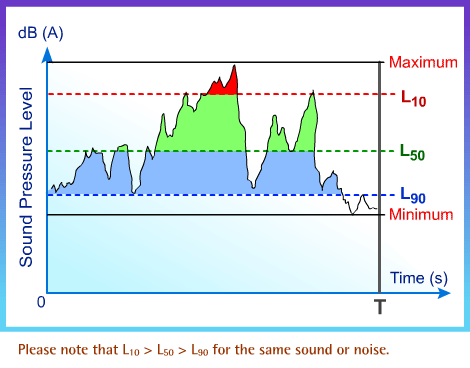Noise Descriptors for Environmental Noise
Noise from different sources can be measured or described in different ways. There are alternative ways to measure or describe even the same type of noise source! Scientists have conducted surveys and laboratory studies aiming to develop descriptors to best correlate community response to various environmental noise sources. This is why different countries have adopted different noise descriptors for assessment of different community noise sources.
In most cases, the sounds and noises we hear are not steady. Apart from variation in tones, the magnitude or the sound pressure level of a sound or noise changes with time.
The n-percent exceeded level, Ln, is the sound pressure level exceeded for n percent of the time. In other words, for n percent of the time, the fluctuating sound pressure levels are higher than the Ln level. Ln can be obtained by analysing a given noise by statistical means.
If the noise is being measured on the A-weighting scale, Ln is often written as LAn.
Let us explain this noise descriptor with some illustrations.
The change of magnitude of a sound or noise over time can be represented by this graph. Please click on the demo button to see the details.
L10 is the level exceeded for 10% of the time. For 10% of the time, the sound or noise has a sound pressure level above L10. For the rest of the time, the sound or noise has a sound pressure level at or below L10. These higher sound pressure levels are probably due to sporadic or intermittent events.
L50 is the level exceeded for 50% of the time. It is statistically the mid-point of the noise readings. It represents the median of the fluctuating noise levels.
L90 is the level exceeded for 90% of the time. For 90% of the time, the noise level is above this level. It is generally considered to be representing the background or ambient level of a noise environment.
For a varying sound, L10 is greater than L50 which in turn is greater than L90. The following graph illustrates L10, L50 and L90.

Traffic noise planning standard in Hong Kong is L10(1 hour) of 70 dB(A) measured over the peak hour of traffic. The standard was formulated after review of similar standards in other developed countries. Field measurement in Hong Kong also revealed that L10(1 hour) of 70 dB(A) over the peak hour is roughly the same as L10(18 hour) of 68 dB(A), for the kind of normal traffic flow situations encountered in Hong Kong.
The traffic noise planning standard, which is L10(1 hour) of 70 dB(A), means that when this limit is just met, traffic noise will exceed 70 dB(A) for 10% of an hour. For the remaining time, the traffic noise will be less than 70 dB(A).
The following diagram explains the concept more clearly. Please click on the demo button to see the details.
When noise or sound is measured in dB(A), it is customary to denote the equivalent continuous sound pressure level as LAeq.
Let us explain Leq or LAeq by using an illustration. Please click on the demo button to see the details.
A fluctuating noise has its magnitude varying quite considerably over time. Examples are road traffic noise, rock music and noise from helicopter flyover.
For an impulsive noise, the level rises sharply and then falls rapidly. Examples include hammering, shooting and firecracker noise.
Let us look at the equivalent continuous sound pressure levels of different types of noises as below. Please note that although the types of noise can be different, traffic noise and hammering may produce the same level of LAeq if the sound energies produced are the same at the receiver. Please click on the demo button to see the details.


